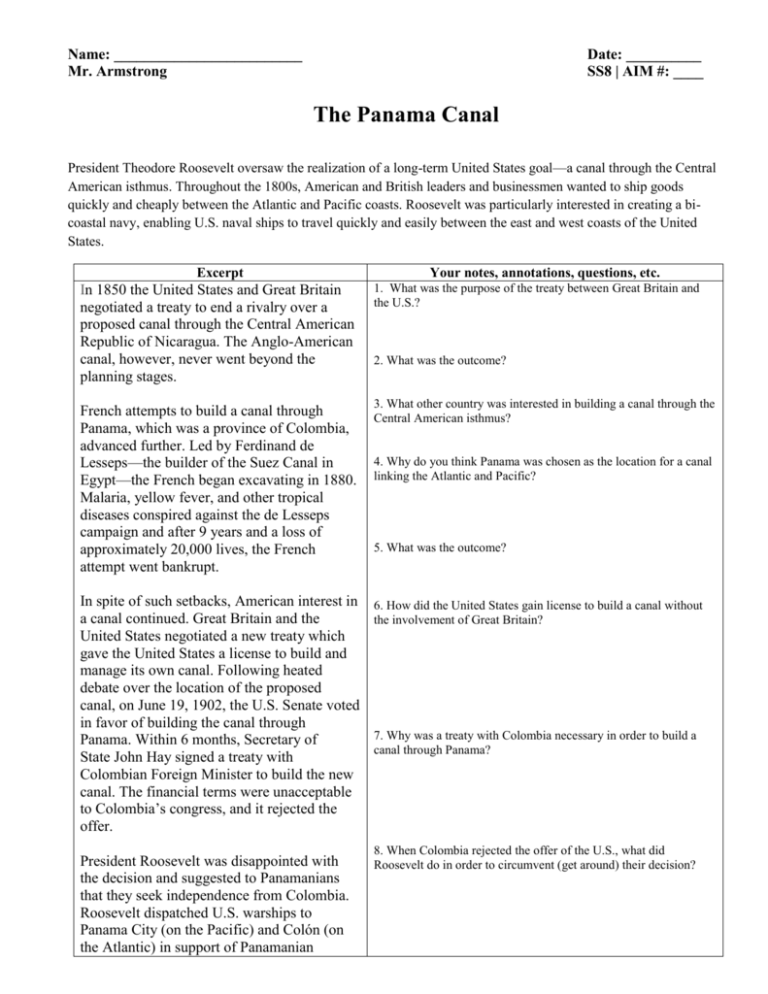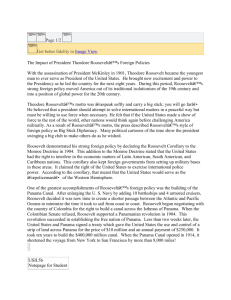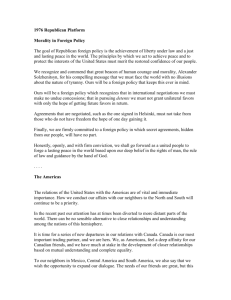Panama Canal Overview WKSHT
advertisement

Name: _________________________ Mr. Armstrong Date: __________ SS8 | AIM #: ____ The Panama Canal President Theodore Roosevelt oversaw the realization of a long-term United States goal—a canal through the Central American isthmus. Throughout the 1800s, American and British leaders and businessmen wanted to ship goods quickly and cheaply between the Atlantic and Pacific coasts. Roosevelt was particularly interested in creating a bicoastal navy, enabling U.S. naval ships to travel quickly and easily between the east and west coasts of the United States. Excerpt In 1850 the United States and Great Britain negotiated a treaty to end a rivalry over a proposed canal through the Central American Republic of Nicaragua. The Anglo-American canal, however, never went beyond the planning stages. French attempts to build a canal through Panama, which was a province of Colombia, advanced further. Led by Ferdinand de Lesseps—the builder of the Suez Canal in Egypt—the French began excavating in 1880. Malaria, yellow fever, and other tropical diseases conspired against the de Lesseps campaign and after 9 years and a loss of approximately 20,000 lives, the French attempt went bankrupt. In spite of such setbacks, American interest in a canal continued. Great Britain and the United States negotiated a new treaty which gave the United States a license to build and manage its own canal. Following heated debate over the location of the proposed canal, on June 19, 1902, the U.S. Senate voted in favor of building the canal through Panama. Within 6 months, Secretary of State John Hay signed a treaty with Colombian Foreign Minister to build the new canal. The financial terms were unacceptable to Colombia’s congress, and it rejected the offer. President Roosevelt was disappointed with the decision and suggested to Panamanians that they seek independence from Colombia. Roosevelt dispatched U.S. warships to Panama City (on the Pacific) and Colón (on the Atlantic) in support of Panamanian Your notes, annotations, questions, etc. 1. What was the purpose of the treaty between Great Britain and the U.S.? 2. What was the outcome? 3. What other country was interested in building a canal through the Central American isthmus? 4. Why do you think Panama was chosen as the location for a canal linking the Atlantic and Pacific? 5. What was the outcome? 6. How did the United States gain license to build a canal without the involvement of Great Britain? 7. Why was a treaty with Colombia necessary in order to build a canal through Panama? 8. When Colombia rejected the offer of the U.S., what did Roosevelt do in order to circumvent (get around) their decision? independence. Colombian troops were unable to negotiate the jungles of the Darien Strait and Panama declared independence on November 3, 1903. The newly declared Republic of Panama negotiated the Hay-Bunau-Varilla Treaty of 1903, which gave the United States permanent rights to a 10-mile wide strip of land for the canal, a one-time $10 million payment to Panama, and an annual payment of $250,000. The United States also agreed to guarantee the independence of Panama. Completed in 1914 at a cost of $345 million, the Panama Canal symbolized U.S. technological prowess and economic power. Although U.S. control of the canal eventually became an irritant to U.S.-Panamanian relations, at the time it was heralded as a major foreign policy achievement. As the 20th century progressed, tensions between the United States and Panama over U.S. control of the Canal grew. Throughout the 1960s and 1970s, much effort went into resolving the tensions. On September 7, 1977, President Jimmy Carter signed a treaty with Panama setting December 31, 1999 as the date the canal would be turned over to the Panamanians, who have controlled it since. 9. How much did the U.S. pay for access to the Panama Canal Zone? 10. How long was the U.S. to be given access to the zone? 11. What did the U.S. promise the new Republic of Panama? 12. Why did Roosevelt go to such great measures to see that the canal was built? 13. Why did the U.S. abandon its permanent access to the zone as granted in the 1903 treaty?







